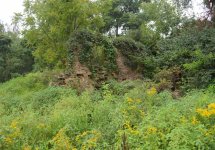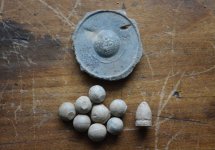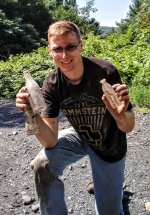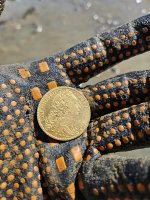RustyRelics
Gold Member
- Apr 5, 2019
- 5,907
- 32,390
- Detector(s) used
- Equinox 600/Ancient Whites MXT
- Primary Interest:
- Relic Hunting
This past week I made some of my best finds of my entire relic hunting career. It may start off slow, but I'll build the suspense for y'all. 
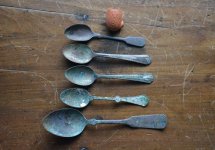
Now before you think this is clickbait, NO, the spoons are not my best finds ever. They're cool though. They date from the 1860s, through the 1920s, and were found in the Ashland Dump, a place outside of Ashland Pa where the town dumped things from the 1850s through the 1960s. There's a lot of stuff mixed in, and most of them are crier bottles. In one area I found a broken union flask and a Coca Cola bottle right next to each other. Nothing made sense there.
They date from the 1860s, through the 1920s, and were found in the Ashland Dump, a place outside of Ashland Pa where the town dumped things from the 1850s through the 1960s. There's a lot of stuff mixed in, and most of them are crier bottles. In one area I found a broken union flask and a Coca Cola bottle right next to each other. Nothing made sense there.
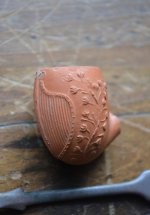
Really cool late 1800s pipe bowl, or the start of a Chia pet? You decide.
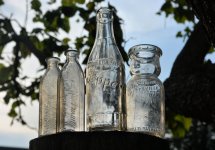
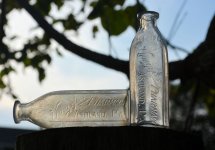
I found lots of local sodas and milks, but the two gems were the Knapps Pharmacy bottles from Ashland Pa. My grandfather and great uncle dug bottles from the 1960s until about 2005. They've seen everything except these two. These two bottles were a mystery to my uncle who is still alive, as he had never found any Knapps bottles. I can't find any photos online of them either, so I think I found my first unlisted small town pharmacy bottles! Knapps pharmacy was a small pharmacy in Ashland from 1911, to 1964 I believe. These bottles date to the teens.
Also found in the dump was a WWII Dogtag, named to Arthur Brosius, dated 1943.
I also had the amazing opportunity to travel to wear my ancestors were born, raised, lived and died, the Lykens Valley in Pennsylvania. Everyone from my 8th Great grandfather, who came over on a boat from Germany in the 1750s, until even today, Trautmans and Troutmans (A Trautman married a Trautman way back when, I'm related to both) made their lives in Klingerstown, Pillow, Spain, Hebe and throughout the valley. A few of the older houses are still standing, like my 8th great grandfathers stone house built in the 1760s, (it's in shambles) and my 5th great grandfathers house built in 1834 (fantastic condition). These were the houses me and my dad went to go and photograph for posterity.
Originally we went to go see Peter Trautmans house, built in 1834 out of stone. The house is now owned by an amish family who at the time are adding an addition onto the old stone house and renovating the interior. The man who owned it was very kind and generous, and was eager to learn more about who lived there when it was built. I told him everything I knew about the occupants from 1834, until 1915, and he was intrigued. When we mentioned that we metal detect, he offered us permission to search the front yard, and Daniel Trautmans house site, which was also on his property. The name Daniel Trautman piqued my interest. Daniel Trautman was a volunteer infantryman in Co. A, 50th PA Vol. and served for nearly the entirety of the war, and fought in many battles from South Mountain and Sharpsburg, to Vicksburg, the Wilderness, Spotsylvania, Petersburg, Cold Harbor and many others. After the war, he fathered 17 children, 15 of which lived to adulthood. He became a well to do farmer in the Lykens valley, but was unfortunately killed by hoodlums in a botched robbery attempt in his own front yard in 1880.
The owner of the house took us to all the houses he knew of in the area that the Trautmans occupied. Daniels, Johann Peters, Martin, and even the Troutman Schoolhouse. He was just happy to see that we were happy, and his only conditions were to let him see what we had found. NO PROBLEM!
My dad and I voted to pay a visit to Daniels house site first, since I had done a lot of digging into Daniels life. When we got to the place, it was evident something was there a long time ago, but it was unfortunately an overgrown site.
After only a few minutes of detecting, I found a small 1830s-1860s flat button marked "Imperial Standard". We knew we were in the right place. In some sections, the place was very overgrown with grass, bushes, saplings, and in other places it was relatively open. This stone wall next to a very old tree was in a more open spot. There were several stone walls like this around, each one being at least 3.5 to 4 ft. high, at least 50 ft. long, and up to 3 ft. thick. In all my years of exploring I've never seen walls like that.
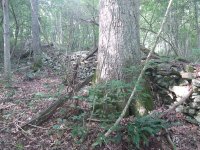
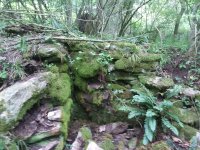
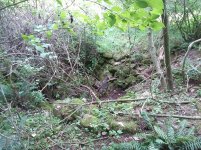
After an hour or so of detecting, we were finding household items; square nails, a spoon, an 1860s lock, another flat button, and odds and ends. Then I swept my coil over a loud iron signal that made me jump. Whatever it was, it was lying right underneath the leaves. When I kicked the leaves away, I was stunned to see a butt plate to a musket!
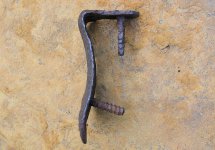
My dad was very surprised, as was I. We had stumbled into a dumping area. A worm syrup or some other kind of med was lying on top of the ground next to a broken wine bottle, a Dr. Jaynes Vermafuge bottle (broken) a clay marble, and other pieces. We ping ponged all over looking for stuff that was laying right on top of the ground. I picked my metal detector back up and went over where I found the butt plate and got another banging signal. This time I reached down and pulled out a whole barrel!

his time my dad and I were both screaming, laughing, yelling, jumping - we jumped right into a hornets nest. We ran like hell, making sure to grab everything we could. We went back the next day armed with bee killer and vanquished the little backstabbers and immediately found the trigger assembly. A Springfield! We could not find the lockplate unfortunately, but as luck would have it, I'll be moving to PA later this year, so maybe I'l find it this winter. It was in the dump, so there are a lot of signals to sort though.
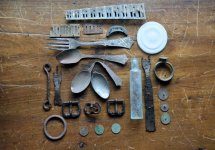
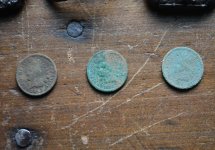
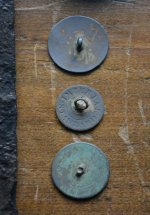
Not shown are some farm tools, two 1860s locks, and a marble. The Indian Head Pennies are dated 1881, 1884, and 188*.
The 50th Pa Vol. were outfitted with Springfield muskets in 1863, and that is what this appears to be. It is in very good condition for the amount of time it's been buried, and is solid. The nipple, the site the trigger, is all intact. It is very, very special to me to find this musket. I've been reading about Daniel for a few years now and to own things that he and his family used, along with the musket he carried during the war, gives me goosebumps.
The man who gave us permission was ecstatic about the find, and even gave us a large board from our 5th great grandfathers attic to mount it on. It is truly a special find that will hang proudly on the wall for as long as I live.
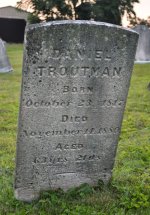


Now before you think this is clickbait, NO, the spoons are not my best finds ever. They're cool though.
 They date from the 1860s, through the 1920s, and were found in the Ashland Dump, a place outside of Ashland Pa where the town dumped things from the 1850s through the 1960s. There's a lot of stuff mixed in, and most of them are crier bottles. In one area I found a broken union flask and a Coca Cola bottle right next to each other. Nothing made sense there.
They date from the 1860s, through the 1920s, and were found in the Ashland Dump, a place outside of Ashland Pa where the town dumped things from the 1850s through the 1960s. There's a lot of stuff mixed in, and most of them are crier bottles. In one area I found a broken union flask and a Coca Cola bottle right next to each other. Nothing made sense there. 
Really cool late 1800s pipe bowl, or the start of a Chia pet? You decide.


I found lots of local sodas and milks, but the two gems were the Knapps Pharmacy bottles from Ashland Pa. My grandfather and great uncle dug bottles from the 1960s until about 2005. They've seen everything except these two. These two bottles were a mystery to my uncle who is still alive, as he had never found any Knapps bottles. I can't find any photos online of them either, so I think I found my first unlisted small town pharmacy bottles! Knapps pharmacy was a small pharmacy in Ashland from 1911, to 1964 I believe. These bottles date to the teens.
Also found in the dump was a WWII Dogtag, named to Arthur Brosius, dated 1943.
I also had the amazing opportunity to travel to wear my ancestors were born, raised, lived and died, the Lykens Valley in Pennsylvania. Everyone from my 8th Great grandfather, who came over on a boat from Germany in the 1750s, until even today, Trautmans and Troutmans (A Trautman married a Trautman way back when, I'm related to both) made their lives in Klingerstown, Pillow, Spain, Hebe and throughout the valley. A few of the older houses are still standing, like my 8th great grandfathers stone house built in the 1760s, (it's in shambles) and my 5th great grandfathers house built in 1834 (fantastic condition). These were the houses me and my dad went to go and photograph for posterity.
Originally we went to go see Peter Trautmans house, built in 1834 out of stone. The house is now owned by an amish family who at the time are adding an addition onto the old stone house and renovating the interior. The man who owned it was very kind and generous, and was eager to learn more about who lived there when it was built. I told him everything I knew about the occupants from 1834, until 1915, and he was intrigued. When we mentioned that we metal detect, he offered us permission to search the front yard, and Daniel Trautmans house site, which was also on his property. The name Daniel Trautman piqued my interest. Daniel Trautman was a volunteer infantryman in Co. A, 50th PA Vol. and served for nearly the entirety of the war, and fought in many battles from South Mountain and Sharpsburg, to Vicksburg, the Wilderness, Spotsylvania, Petersburg, Cold Harbor and many others. After the war, he fathered 17 children, 15 of which lived to adulthood. He became a well to do farmer in the Lykens valley, but was unfortunately killed by hoodlums in a botched robbery attempt in his own front yard in 1880.
The owner of the house took us to all the houses he knew of in the area that the Trautmans occupied. Daniels, Johann Peters, Martin, and even the Troutman Schoolhouse. He was just happy to see that we were happy, and his only conditions were to let him see what we had found. NO PROBLEM!
My dad and I voted to pay a visit to Daniels house site first, since I had done a lot of digging into Daniels life. When we got to the place, it was evident something was there a long time ago, but it was unfortunately an overgrown site.
After only a few minutes of detecting, I found a small 1830s-1860s flat button marked "Imperial Standard". We knew we were in the right place. In some sections, the place was very overgrown with grass, bushes, saplings, and in other places it was relatively open. This stone wall next to a very old tree was in a more open spot. There were several stone walls like this around, each one being at least 3.5 to 4 ft. high, at least 50 ft. long, and up to 3 ft. thick. In all my years of exploring I've never seen walls like that.



After an hour or so of detecting, we were finding household items; square nails, a spoon, an 1860s lock, another flat button, and odds and ends. Then I swept my coil over a loud iron signal that made me jump. Whatever it was, it was lying right underneath the leaves. When I kicked the leaves away, I was stunned to see a butt plate to a musket!

My dad was very surprised, as was I. We had stumbled into a dumping area. A worm syrup or some other kind of med was lying on top of the ground next to a broken wine bottle, a Dr. Jaynes Vermafuge bottle (broken) a clay marble, and other pieces. We ping ponged all over looking for stuff that was laying right on top of the ground. I picked my metal detector back up and went over where I found the butt plate and got another banging signal. This time I reached down and pulled out a whole barrel!

his time my dad and I were both screaming, laughing, yelling, jumping - we jumped right into a hornets nest. We ran like hell, making sure to grab everything we could. We went back the next day armed with bee killer and vanquished the little backstabbers and immediately found the trigger assembly. A Springfield! We could not find the lockplate unfortunately, but as luck would have it, I'll be moving to PA later this year, so maybe I'l find it this winter. It was in the dump, so there are a lot of signals to sort though.



Not shown are some farm tools, two 1860s locks, and a marble. The Indian Head Pennies are dated 1881, 1884, and 188*.
The 50th Pa Vol. were outfitted with Springfield muskets in 1863, and that is what this appears to be. It is in very good condition for the amount of time it's been buried, and is solid. The nipple, the site the trigger, is all intact. It is very, very special to me to find this musket. I've been reading about Daniel for a few years now and to own things that he and his family used, along with the musket he carried during the war, gives me goosebumps.
The man who gave us permission was ecstatic about the find, and even gave us a large board from our 5th great grandfathers attic to mount it on. It is truly a special find that will hang proudly on the wall for as long as I live.



